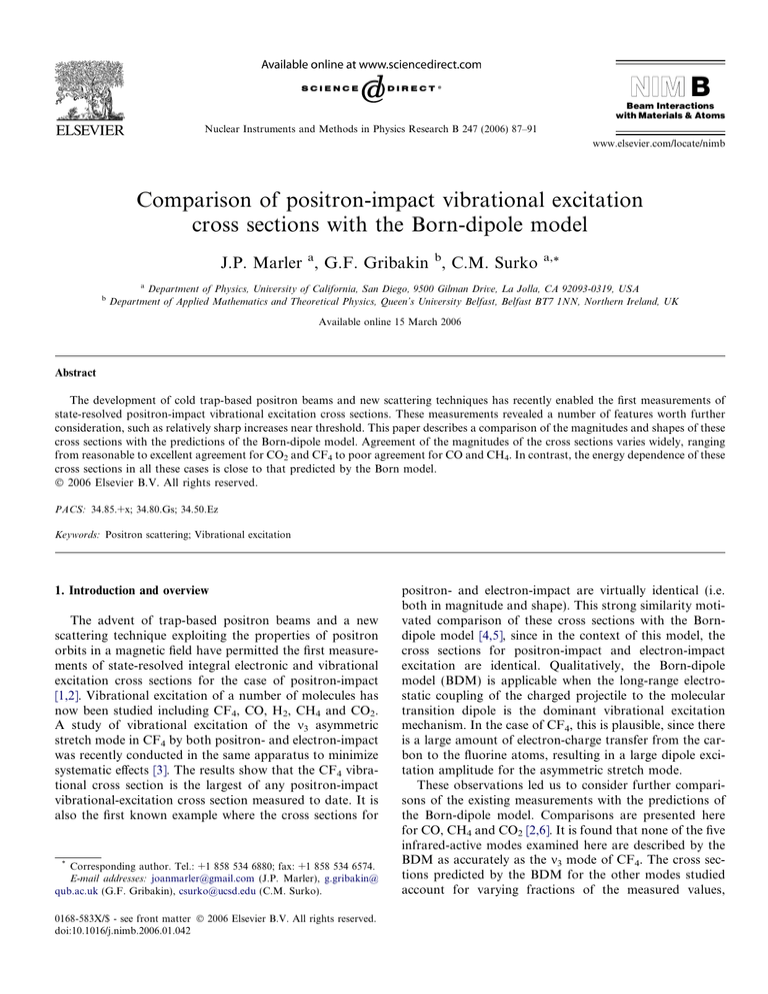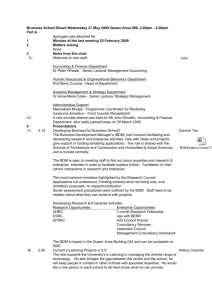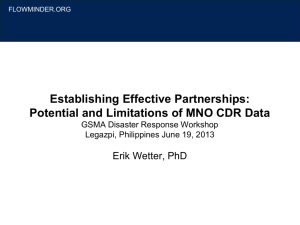
NIM B
Beam Interactions
with Materials & Atoms
Nuclear Instruments and Methods in Physics Research B 247 (2006) 87–91
www.elsevier.com/locate/nimb
Comparison of positron-impact vibrational excitation
cross sections with the Born-dipole model
J.P. Marler a, G.F. Gribakin b, C.M. Surko
b
a,*
a
Department of Physics, University of California, San Diego, 9500 Gilman Drive, La Jolla, CA 92093-0319, USA
Department of Applied Mathematics and Theoretical Physics, Queen’s University Belfast, Belfast BT7 1NN, Northern Ireland, UK
Available online 15 March 2006
Abstract
The development of cold trap-based positron beams and new scattering techniques has recently enabled the first measurements of
state-resolved positron-impact vibrational excitation cross sections. These measurements revealed a number of features worth further
consideration, such as relatively sharp increases near threshold. This paper describes a comparison of the magnitudes and shapes of these
cross sections with the predictions of the Born-dipole model. Agreement of the magnitudes of the cross sections varies widely, ranging
from reasonable to excellent agreement for CO2 and CF4 to poor agreement for CO and CH4. In contrast, the energy dependence of these
cross sections in all these cases is close to that predicted by the Born model.
Ó 2006 Elsevier B.V. All rights reserved.
PACS: 34.85.+x; 34.80.Gs; 34.50.Ez
Keywords: Positron scattering; Vibrational excitation
1. Introduction and overview
The advent of trap-based positron beams and a new
scattering technique exploiting the properties of positron
orbits in a magnetic field have permitted the first measurements of state-resolved integral electronic and vibrational
excitation cross sections for the case of positron-impact
[1,2]. Vibrational excitation of a number of molecules has
now been studied including CF4, CO, H2, CH4 and CO2.
A study of vibrational excitation of the m3 asymmetric
stretch mode in CF4 by both positron- and electron-impact
was recently conducted in the same apparatus to minimize
systematic effects [3]. The results show that the CF4 vibrational cross section is the largest of any positron-impact
vibrational-excitation cross section measured to date. It is
also the first known example where the cross sections for
*
Corresponding author. Tel.: +1 858 534 6880; fax: +1 858 534 6574.
E-mail addresses: joanmarler@gmail.com (J.P. Marler), g.gribakin@
qub.ac.uk (G.F. Gribakin), csurko@ucsd.edu (C.M. Surko).
0168-583X/$ - see front matter Ó 2006 Elsevier B.V. All rights reserved.
doi:10.1016/j.nimb.2006.01.042
positron- and electron-impact are virtually identical (i.e.
both in magnitude and shape). This strong similarity motivated comparison of these cross sections with the Borndipole model [4,5], since in the context of this model, the
cross sections for positron-impact and electron-impact
excitation are identical. Qualitatively, the Born-dipole
model (BDM) is applicable when the long-range electrostatic coupling of the charged projectile to the molecular
transition dipole is the dominant vibrational excitation
mechanism. In the case of CF4, this is plausible, since there
is a large amount of electron-charge transfer from the carbon to the fluorine atoms, resulting in a large dipole excitation amplitude for the asymmetric stretch mode.
These observations led us to consider further comparisons of the existing measurements with the predictions of
the Born-dipole model. Comparisons are presented here
for CO, CH4 and CO2 [2,6]. It is found that none of the five
infrared-active modes examined here are described by the
BDM as accurately as the m3 mode of CF4. The cross sections predicted by the BDM for the other modes studied
account for varying fractions of the measured values,
J.P. Marler et al. / Nucl. Instr. and Meth. in Phys. Res. B 247 (2006) 87–91
ranging from about 60% for the m2 mode of CO2 to less
than 20% for the sum of the m3 + m1 modes of CH4. However the energy dependence of all cross sections is quite
similar to the Born-model prediction. In contrast, the measured cross section for H2 (i.e. a case where the dipole coupling is zero due to symmetry) has a qualitatively different
energy dependence. Other trends in the data are discussed,
including comparisons with measured electron-impact
cross sections where available.
The experimental measurements discussed here were
made with a cold, trap-based positron beam [7] with an
energy resolution of 25 meV, FWHM. Scattering was studied using a method that exploits the orbits of the positrons
in a strong magnetic field [1,2,8]. This technique has proven
to be particularly useful in measuring absolute integral
inelastic excitation cross sections (i.e. without the need
for normalization to other data). The experimental technique is described in detail in [8], and as applied specifically
to measurement of vibrational excitation cross sections, it
is also described in [1,2].
2. Born-dipole approximation
While the Born approximation is typically regarded as
valid only at high energies, another region of applicability
is the one considered here. Due to the low energy of molecular vibrational excitations and long-range nature of the
charge-dipole coupling, the amplitude of vibrational excitation of an infrared-active mode is dominated by large
projectile-target distances. In this case, the projectile wavefunction is only weakly perturbed by the interaction with
the target. In addition, for projectile energies somewhat
higher than threshold, many partial waves with large angular momenta contribute to the cross section (classically,
large impact parameters are important). These partialwave components of the projectile wavefunction are close
to the corresponding components of a plane wave.
In the BDM, the differential and integral cross sections
of the vibrational excitation of mode n of a molecule are
given by [4,5],
dr 4k 0
M dn
¼
;
2
02
dX 3k k þ k 2kk 0 cos h
8p
r ¼ 2 M dn ln½ðk þ k 0 Þ=ðk k 0 Þ;
3k
ð1Þ
ð2Þ
wherepffiffiffiffiffiffiffiffiffiffiffiffiffiffiffiffiffiffi
all quantities are in atomic units; k and
0
k ¼ k 2 2xn are the initial and final positron (electron)
momenta, xn is the energy of the mode and M dn is the dipole
transition strength, including the mode degeneracy factor.
The absolute values of the transition strengths, M dn , and
henceqthe
ffiffiffiffiffiffiffi effective transition dipole matrix elements,
Dn ¼ M dn , for many molecules and modes have been
determined by infrared absorption measurements [9,5].
Eqs. (1) and (2) provide absolute predictions of the differential and integral cross sections for vibrational excitation
by positron- or electron-impact.
A comparison of the BDM with measured cross sections
for both positron- and electron-impact excitation of the m3
vibrational mode of CF4 has recently been presented in [3].
As shown in Fig. 1, both the positron and electron data are
in good, absolute agreement with the BDM predictions.
The measurements shown in Fig. 1 for both positrons
and electrons are the first direct, integral, state resolved
cross section measurements for the m3 mode of CF4. Other
measurements of the integral cross section for electrons
using swarm techniques [10,11] and a combination of differential cross section measurements and the BDM [12]
are discussed in [3].
In CF4, there is extensive electron charge-transfer
between the carbon and fluorine atoms, resulting in strong
dipole coupling to the asymmetric stretch mode. For molecules with smaller transition dipole amplitudes, the longrange dipole coupling will give a smaller contribution to
the excitation amplitude. One can expect that, in this case,
short-range effects not described by the BDM may become
relatively more important, leading to deviations of the
cross sections from the predictions of Eqs. (1) and (2).
In Figs. 2–5, we compare the predictions of the BDM
with positron-impact data for the other molecules and
modes studied to date. Note that in Fig. 4, the data correspond to the pairs of modes, m1 + m3 and m2 + m4, since the
experimental resolution was insufficient to resolve the individual members of each pair. In this case, one mode in each
pair (i.e. the m3 and m4 modes) is infrared active. The other
two modes (m1 and m2) are not infrared active, resulting in
an absence of dipole coupling.
To quantify the degree of disagreement between the
BDM and the measurements and to analyze the energy
dependence of the cross sections, we show the BDM predictions scaled to fit the experimental data. In particular,
we assume that rexp = fBDrB, where rB is the Born-dipole
30
CF4
25
Cross section (a20)
88
positrons
electrons
20
15
10
5
0
0.0
0.2
0.4
0.6
0.8
1.0
1.2
1.4
1.6
1.8
2.0
2.2
Energy (eV)
Fig. 1. Comparison of the experimental results for positron-impact
excitation of the m3 mode of CF4 [3] with: (—) the Born-dipole model
[5], and (- -) the Born-dipole model with the magnitude adjusted to fit the
data. Also shown for comparison are the electron-impact data (s) taken
using the same experimental apparatus [3].
J.P. Marler et al. / Nucl. Instr. and Meth. in Phys. Res. B 247 (2006) 87–91
8
6
CO2
CO2
5
3
4
2
Cross section (a 20 )
6
Cross section (a 20 )
89
2
4
3
2
1
0
0
4
2
6
Energy (eV)
0
0
4
2
6
Energy (eV)
Fig. 2. Comparison of the experimental results for positron-impact excitation of the (left) m3, and (right) m2 vibrational modes of CO2 [2] with (—) the
Born-dipole model [5]; (- -) the Born-dipole model with the magnitude adjusted to fit the data; and (– –) the predictions of Kimura et al. [13]. The Born
model can account for about 63% of the measured cross section for the m3 mode and all of the cross section for the m2 mode. Note that the energy
dependence predicted by the BDM for the m3 mode agrees well with the measured cross section.
2.5
CO
2
Cross section (a 0 )
2.0
1.5
1.0
0.5
0.0
0
4
2
6
Energy (eV)
Fig. 3. Comparison of the experimental results for positron-impact
excitation of CO [2] with (—) the Born-dipole model [5]; (- -) the Born
model with the amplitude adjusted to fit the data; (– –) the predictions of
Gianturco et al. [14]; and (– ÆÆ –) the predictions of Jain [15]. The Born
model can account for about 36% of the measured cross section and fits
the shape quite well. Also shown for comparison are the electron-impact
data (s, ,)from [16] and [17]. Above 1.5 eV (i.e. in the region of the 2P
resonance) the data of [16] (h) have been multiplied by 0.1.
cross section, rexp is the measured cross section, and fBD is
a fitting constant for each mode or unresolved mode pair.
Comparisons of the magnitudes of the predicted and measured spectra are summarized in Table 1. Of all cases studied, CF4 is the only one where the BDM accounts for all of
the measured cross section. In fact, it overestimates the
peak cross section by almost 30%. In contrast, the results
of Figs. 2–4 show varying and generally lesser degrees of
agreement with the Born model. The values of rB from
the BDM are shown by the solid lines in Figs. 2–4. Table
1 also shows the transition dipole matrix element, Dn,
and the values of fBD that yield best fits to the data. With
regard to comparisons of the magnitudes of the cross sections, the BDM predictions for CF4 and CO2 agree reasonably well with the measurements, especially the low-energy
bending mode m2 (albeit over a limited range of data), with
less good agreement for the other targets studied. Note that
after CF4, CO2 has the largest vibrational excitation cross
section in the Born-dipole approximation, with those of
CO and CH4 smaller by a factor of four or more. In the
later two cases, the weakness of the long-range dipole coupling makes other short-range contributions to the amplitude more important. In the case of the m1 + m3 modes of
CH4, dipole coupling accounts for only 18% of the measured cross section.
As shown in Fig. 2, the theoretical predictions of [13] for
CO2 are in good agreement with experiment for the m3
mode, and those of [14] describe the data for CO quite well
(Fig. 3). In contrast, Fig. 4 shows that the theoretical
results of [18] for both cross sections in CH4 fall considerably below the experimental data.
In contrast with the widely varying degrees of agreement
between the BDM and the magnitudes of the measured
cross sections, the shapes of the measured spectra agree
fairly well with the Born model for all targets studied
except H2, which is the one case where the dipole coupling
is absent. In particular, the Born model prediction captures
the general trend of the data that show a sharp rise in the
cross section near threshold followed by a monotonic and
rather slow decrease at higher energies. The measured cross
section for H2 also rises sharply from threshold (cf. Fig. 5).
However, it decreases much faster than the BDM prediction after the maximum. Whether the agreement for the
shapes of the cross sections for CO2, CO, and CH4 is significant, even when the magnitudes of the BDM predictions are significantly smaller than the measurements, or
is merely a coincidence, is presently unclear. In this regard,
the H2 data provide an example of a case where the dependence of the cross section on energy is distinctly different
than that predicted by the BDM.
While the sharp rise in the cross section near threshold is
seen in the electron-impact data for CF4, to our knowledge
there are no directly measured integral electron-impact
vibrational cross sections for the other targets and modes
90
J.P. Marler et al. / Nucl. Instr. and Meth. in Phys. Res. B 247 (2006) 87–91
3.0
3.5
2.5
2.0
1.5
1.0
0.5
0.0
CH4
3.0
positrons
electrons
Cross section (a20)
Cross section (a20)
ν1 + ν3
CH4
ν2 + ν4
positrons
electrons
2.5
2.0
1.5
1.0
0.5
0
1
2
3
4
5
6
0.0
0
1
Energy (eV)
2
3
4
Energy (eV)
Fig. 4. Experimental results for positron-impact excitation of the unresolved pairs of modes (left) m1 + m3, and (right) m2 + m4 vibrational modes of CH4 [6].
Shown for comparison are (—) the Born-dipole model for the infrared-active modes (left) m3; and (right) m4; (- -) the Born model with amplitudes adjusted
to fit the data; and (— ) the predictions of [18]. While the Born model can account for only a relatively small fraction of the cross sections, it fits the shapes
of the cross sections reasonably well. For comparison, open symbols are electron-impact data from [19].
0.5
H2
Cross section (a20)
0.4
0.3
0.2
0.1
0.0
0
1
2
3
4
Energy (eV)
Fig. 5. Experimental results for positron-impact excitation of H2 from [2].
Note that, in contrast to the data shown for the other molecules studied,
the energy dependence of the measured cross section differs markedly from
that of the BDM (—). This is expected, since the dipole coupling for H2 is
zero by symmetry.
considered here. Thus, the behavior of the electron-impact
cross sections near threshold remains to be determined. In
principal, this, and systematic comparisons with the analogous positron cross sections, could be done using the
trap-based beam apparatus and an electron source, as
was used for the recent study of CF4 [3].
There are, however, measurements of differential vibrational excitation cross sections (DCS) by electrons for all of
the molecules listed in Table 1. In particular, data at 1 eV
and higher energies are available for CF4 [5], CO2 [20], CO
[16,17] and CH4 [19]. Thus a comparison of the measured
electron-impact DCS with Eq. (1) then allows us to compare the applicability of the BDM for positrons and electrons for the same molecules and modes.
For the m3 mode in CF4, the DCS at 2 eV (i.e. the lowest
energy studied) measured at 20°, 50° and 90° are within
about 10% of the prediction of the BDM. This agreement
is similar to that in [3] for the integral positron and electron
cross sections for CF4. In CO2, the electron DCS for the m2
bending mode is very close to the BDM prediction over the
measurement range, 15° < h < 105°, at 0.33 and 1.05 eV
[20]. This cross section is strongly forward-peaked, suggesting that the corresponding integral cross section would also
be in accord with the BDM. This is in accord with the
positron results (cf. Fig. 2, right panel) that show good
agreement with the BDM, at least over the limited range
for which data is available. The measured electron-impact
DCS for the m3 (asymmetric stretch) mode in CO2 is about
30% larger than the BDM at 0.53 eV (evaluated using a
Table 1
Comparison of the Born-dipole model predictions with integral, positron-impact vibrational-excitation cross section measurements
Molecule
Mode number
xn (eV)
Dn (a.u.)
rexp (1 eV) (a20 )
rB (1 eV) (a20 )
1
fBD
CF4
CO2
CO2
CO
CH4
CH4
H2
3
3
2
1
4 [2]a
3 [1]a
1
0.159
0.291
0.083
0.266
0.163 [0.190]
0.374 [0.362]
0.545
0.210
0.113
0.067
0.042
0.039
0.037
0
15
5.8
2.4
1.25
1.8
1.6
0.33
16.5
3.7
1.9
0.53
0.54
0.33
n.a.
1.28
0.63
1.0
0.36
0.29
0.18
n.a
Tabulated are the mode frequencies, xn, the transition dipole matrix elements Dn from Ref. [9], the experimental and Born predictions for the cross
1
sections at 1 eV, and the fraction of the cross section, fBD
, accounted for by the Born model.
a
Infrared inactive mode; provides no contribution to Dn.
J.P. Marler et al. / Nucl. Instr. and Meth. in Phys. Res. B 247 (2006) 87–91
corrected value of Dn from Table 1, that is smaller than
Dn = 0.126 a.u. used in [20]), and about 10–15% larger at
1.05 eV. This discrepancy is qualitatively similar to that
observed in Fig. 2 (left panel), where the BDM prediction
is smaller than the measured integral positron-impact cross
section.
Electron-impact DCS data are available for CO at 1 eV
[16], and also for CH4 at 1 eV (m2 + m4 modes, not resolved)
and at 2 eV (m2 + m4 and m1 + m3 modes) [19]. These DCS
show evidence of forward peaking consistent with Eq.
(1). In fact, the data for CO of [17] show that experiment
and the BDM agree well at 20° below 1 eV. However, the
measured cross sections for both CO and CF4 are consistently higher than the BDM values at larger angles
(h > 30°). This is particularly true for the m2 + m4 modes
of CH4. At higher energies in CO, the DCS are quite
different than the prediction of the Born model due to a
prominent 2P electron shape resonance at 2 eV. These
observations and a comparison with calculated integral
cross sections presented in [16,17,19] suggest that the
BDM underestimates the low-energy electron vibrational
excitation cross section by a few tens of percent in CO
and by up to a factor of two or more in CH4.
The positron data shown in Figs. 3 and 4 point to even
larger discrepancies. A possible explanation for this difference is that the positron-target interaction may be stronger
than its electron counterpart (e.g. due to the strong virtual
positronium correlations). Such an interaction affects the
low partial waves, whose contributions dominate at low
energies, while at higher energies the Born-dipole condition
kR 1 (R being the radius of the target) is violated, rendering the BDM inapplicable.
3. Summary and concluding remarks
Studies of state-resolved positron-impact cross sections
for electronic and vibrational excitation of atoms and
molecules is in its infancy, and the underlying physical
excitation mechanisms have yet to be fully elucidated. In
this paper, we have compared the limited set of vibrational
cross sections measured to date with arguably the simplest
excitation mechanism and theory, namely the Born-dipole
model that considers only the long-range coupling of the
induced molecular dipole with the Coulomb field of the
positron, which is described by plane waves.
This Born-dipole approximation, with the dipole
strength determined from infrared absorption data, was
used to predict the absolute value of the cross sections
for positron- and electron-impact. The results indicate that
this dipole coupling is always significant (e.g. at the P18%
91
level), and in selected cases, the BDM model can explain
most of the magnitude of the observed positron-impact
cross sections. For all molecules studied except H2, the
BDM model predicts the shapes of the cross sections as a
function of energy quite well. As stated above, whether this
agreement is significant, even when the magnitudes of the
BDM predictions are significantly smaller than the measurements, or is merely a coincidence, is presently unclear.
We note that there is less data available for integral, stateresolved, electron-impact vibrational excitation cross sections than for the analogous positron cross sections, and
relatively little of the latter. Further experimental work to
make systematic comparisons of positron- and electronimpact cross sections would be of considerable interest.
Acknowledgement
This work is supported by the National Science Foundation, Grant PHY 02-44653.
References
[1] S.J. Gilbert, R.G. Greaves, C.M. Surko, Phys. Rev. Lett. 82 (1999)
5032.
[2] J.P. Sullivan, S.J. Gilbert, C.M. Surko, Phys. Rev. Lett. 86 (2001)
1494.
[3] J.P. Marler, C.M. Surko, Phys. Rev. A 72 (2005) 062702.
[4] N.F. Lane, Rev. Mod. Phys. 52 (1980) 29.
[5] A. Mann, F. Linder, J. Phys. B 25 (1992) 545.
[6] J.P. Sullivan, S.J. Gilbert, J.P. Marler, L.D. Barnes, S.J. Buckman, C.
Surko, Nucl. Instr. and Meth. B 192 (2002) 3.
[7] S.J. Gilbert, C. Kurz, R.G. Greaves, C.M. Surko, Appl. Phys. Lett.
70 (1997) 1944.
[8] J.P. Sullivan, S.J. Gilbert, J.P. Marler, R.G. Greaves, S.J. Buckman,
C.M. Surko, Phys. Rev. A 66 (2002) 042708.
[9] L.M. Bishop, L.M. Cheung, J. Phys. Chem. Ref. Data 11 (1982)
119.
[10] M. Hayashi, in: L.C. Pitchford et al. (Eds.), Swarm Studies and
Inelastic Electron–Molecule Collisions, Springer, Berlin, 1987, p. 167.
[11] L.E. Kline, T.V. Congedo, Bull. Am. Phys. Soc. 34 (1989) 325.
[12] R.A. Bonham, Jpn. J. Appl. Phys. 33 (1994) 4157.
[13] M. Kimura, M. Takekawa, Y. Itikawa, H. Takaki, O. Sueoka, Phys.
Rev. Lett. 80 (1998) 3936.
[14] F.A. Gianturco, T. Mukherjee, P. Paioletti, Phys. Rev. A 56 (1997)
3638.
[15] A. Jain, J. Phys. B 19 (1986) L379.
[16] J.C. Gibson, L.A. Morgan, R.J. Gulley, M.J. Brunger, C.T. Bundschu, S.J. Buckman, J. Phys. B 29 (1996) 3197.
[17] W. Sohn, K.H. Kochem, K. Jung, H. Ehrhardt, E.S. Chang, J. Phys.
B 18 (1985) 2049.
[18] T. Nishimura, F.A. Gianturco, Phys. Rev. A 65 (2002) 062703.
[19] C.T. Bundschu, J.C. Gibson, R.J. Gulley, M.J. Brunger, S.J.
Buckman, N. Sanna, F.A. Gianturco, J. Phys. B 30 (1997) 2239.
[20] K.-H. Kochem, W. Sohn, N. Hebel, K. Jung, H. Ehrhardt, J. Phys. B
18 (1985) 4455.





